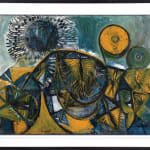Avinash Chandra
Untitled (Landscape with Planets and Sunflowers), 1960
Oil on board
76.2 x 100.6 cm
30 x 39 5/8 in
30 x 39 5/8 in
Signed and dated 'Avinash 60' lower right, further signed and dated 'Avinash 1960' on the reverse, also bearing label of Page Art Inc, California
Further images
'Landscape with Planets and Sunflowers' was painted three years after Chandra’s first solo-show at the Imperial Institute. The following years would see success and international acclaim for Chandra’s paintings. In...
'Landscape with Planets and Sunflowers' was painted three years after Chandra’s first solo-show at the Imperial Institute. The following years would see success and international acclaim for Chandra’s paintings. In 1962 he won the Prix Européen (European Prize) and was the first Indian artist to be exhibited both in Documenta, Kassel (1964) and Tate Britain (1965), the later acquiring his painting Hills of Gold, the first painting by an Indian artist to be held in the Tate collection.
Chandra’s paintings from the late 1950s were formally structured, block like townscapes, rendered in mostly intense colours. In the early 1960s his style evolved and the rigidity of his depiction loosened to encompass more sensual forms, often accompanied by swirling suns and moons.
“In Avinash Chandra’s work, sexual images play a vital role but it is important to realise that they are almost always introduced as part of a much larger experience and in a wider context. They are symbols of exuberance, resilience, toughness and delight and part of their appeal lies in their constant blending with other poetic images: spires, trees, flowers, orchards, hills, moons and stars. It is the complexity of his meanings, the ambiguity of his forms that is perhaps this painter’s special quality...
“His pictures, with their ardent colours, taut rhythms and poetic images are perhaps the strongest proof we have that Indian painting can be vitally modern yet, through these very qualities, remain deeply and traditionally Indian.”
W. G. Archer
From his introduction to Indian Painting Now, 1965
Chandra’s paintings from the late 1950s were formally structured, block like townscapes, rendered in mostly intense colours. In the early 1960s his style evolved and the rigidity of his depiction loosened to encompass more sensual forms, often accompanied by swirling suns and moons.
“In Avinash Chandra’s work, sexual images play a vital role but it is important to realise that they are almost always introduced as part of a much larger experience and in a wider context. They are symbols of exuberance, resilience, toughness and delight and part of their appeal lies in their constant blending with other poetic images: spires, trees, flowers, orchards, hills, moons and stars. It is the complexity of his meanings, the ambiguity of his forms that is perhaps this painter’s special quality...
“His pictures, with their ardent colours, taut rhythms and poetic images are perhaps the strongest proof we have that Indian painting can be vitally modern yet, through these very qualities, remain deeply and traditionally Indian.”
W. G. Archer
From his introduction to Indian Painting Now, 1965
Provenance
Molton Gallery, London;
Elsie De Vries, Los
Angeles, USA;
Page Art, California, USA, acquired from the estate of De Vries in 1996;
Leslie Sacks Fine Art, Santa Monica, Los Angeles, USA;
Saffronart, 6 December 2005, lot 82;
Private UK collection;South Asian Modern + Contemporary Art, Christie's London, June 9, 2011, lot 102;
Private British collection;
Grosvenor Gallery, London
Exhibitions
Grosvenor Gallery, London, South Asian Modern Art 2022, 10 June – 1 July 2022, No. 4, (illustrated in the catalogue, unpaginated)Grosvenor Gallery, London, Gallery One and the Indian Avant Garde, 11 – 15 October 2023, No. 12, (illustrated in the catalogue, p. 47)













